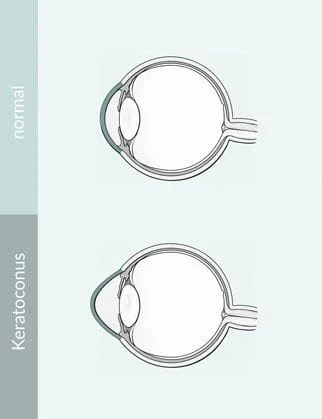Our ophthalmologist office near San Diego is available for corneal cross-linking.
What is Cross-Linking?
Corneal cross-linking is a minimally invasive procedure that treats degenerative conditions of the cornea such as keratoconus. The outpatient procedure strengthens the cornea by adding new links in the collagen fibers within the cornea.
Corneal cross-linking is a two-step process. First, Vitamin B drops are placed on the surface of the eye. Next, the eye is exposed to ultraviolet light. The procedure can be performed with the thin outer layer of the eye, or epithelium, in place or Dr. Nathan Anderson may opt to remove it. Removing the epithelium allows the drops to more easily penetrate the cornea.
Benefits of Cross-Linking
Cross-linking has been shown to retain corneal shape which prevents severe vision loss among patients with progressive keratoconus. For these patients, cross-linking is most beneficial when the cornea is relatively regular in shape and the patient still retains vision. If conducted early enough, cross-linking can stabilize the cornea, improving vision, and making it more comfortable to wear contact lenses. Patients who had radial keratotomy in the 1980s and 1990s may also experience fewer daily fluctuations by having cross-linking performed.
Cross-linking may also be beneficial to patients with corneal infections and ulcer which are unresponsive to topical treatments. Some patients who are planning to have LASIK surgery at Anderson Family Ophthalmology should also consider cross-linking as a form of pre-treatment that strengthens the cornea.
What to Expect Before, During and After Corneal Cross-Linking
Before the procedure, Dr. Anderson will measure the thickness of your cornea and map its shape using a process called corneal topography. You may also have a general eye exam and vision test to determine the overall health of your eye.
The procedure itself takes about an hour and is conducted in an outpatient setting. Patients remain awake during the procedure, which shouldn't cause discomfort. However, a mild sedative can be provided. If applicable, anesthetic drops will be applied and the epithelium will be removed. Vitamin B Drops will be added to your eye(s). After a period of time has passed, Dr. Anderson will measure the thickness of your cornea and determine if it has absorbed enough of the Vitamin B solution. Then, ultraviolet light will be applied to your eye(s) for up to 30 minutes.
Most patients wear a bandage contact lens to reduce irritation and speed healing. Antibiotic and anti-inflammatory drops will also be prescribed. Patients should avoid rubbing their eyes for several days after cross-linking and may experience sensitivity to light and gritty sensation in their eyes.
Call Anderson Family Ophthalmology at 800-462-8749 today if you think you may benefit from corneal cross-linking procedure.


